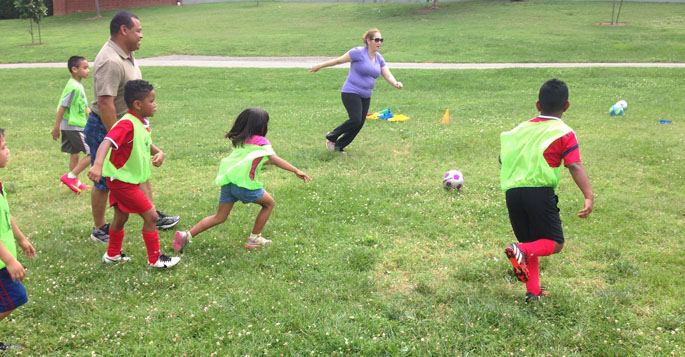
Most preschool-age children manage to get enough recommended daily physical activity, but how they move varies with noticeable differences between boys and girls, a new Vanderbilt study found.
Moderate-to-vigorous physical activity (MVPA) has proven health benefits and outcomes, including prevention and treatment of obesity. The National Academy of Medicine recommends that children achieve at least three hours of all types of physical activity each day, including at least 60 minutes of moderate-to-vigorous physical activity.
Unlike adults, children achieve the recommended amounts of physical activity through shorter energy spurts. On average it takes a preschooler about 11 hours to reach their recommended MVPA.
Researchers on the study, published recently in the journal BMC Public Health, found through closer examination that boys and girls, ages 2 to 5 years, achieve their MVPA requirements in different ways. This information could shed light on physical activity programs and policies for preschool-aged children.
Researchers found that boys tend to perform clustered-sustained spurts, like playing soccer, where there is a lot of running with short pauses in between. Girls’ spurts, meanwhile, are more isolated, lasting less than a minute, such as a quick burst across a room to greet someone followed by sedentary behavior.
“We think it is important to characterize MVPA beyond quantity because it gives us a window into why there might be an emerging gender gap in MVPA,” said the study’s senior author Shari Barkin, MD, MSHS, the William K. Warren Foundation Professor of Medicine, director of Pediatric Obesity Research, and chief of the Division of General Pediatrics at Monroe Carell Jr. Children’s Hospital at Vanderbilt.
“We didn’t see any difference with the ability of children, boys or girls, to achieve their total recommended amount when they are preschoolers. But we know as soon as children enter elementary school, we see a divergence. Boys are able to achieve their recommended amount more than girls, and that gap gets worse as they get older.”
“By understanding the natural inclination of preschool-aged girls to move in more isolated spurts versus preschool-aged boys’ natural inclination to move in clustered sustained spurts, we have a window into how we can support sustained recommended amounts of MVPA as children age, hopefully reducing the gender gap,” Barkin added.
Study participants included 1,131 eligible children from socioeconomically disadvantaged families at risk for obesity who were enrolled in two obesity prevention trials at Vanderbilt University Medical Center and University of Minnesota in Minneapolis. The children wore movement monitors (accelerometers) on their right hip 24 hours a day for seven days.
Overall, four types of physical activity patterns were identified in the study:
- Isolated spurt — a short burst of energy lasting less than one minute, with sedentary behavior before and after.
- Isolated-sustained spurt — sedentary for more than minute, followed by more than a minute of MVPA, then sedentary behavior.
- Clustered spurt — a seesaw back and forth of sedentary behavior less than one minute and MVPA less than one minute, i.e., a game of tag.
- Clustered-sustained spurt — less than one minute of sedentary behavior followed by several minutes of MVPA before returning to less than a minute of sedentary behavior.
Researchers also found that while both genders achieved the MVPA amount, boys spent on average a greater amount of time in MVPA, about 13.5 more minutes per day, than girls. With regards to patterns, girls spent most MVPA in isolated and clustered spurts, while boys spent more time in clustered-sustained spurts.
Other researchers who contributed to this study include: Rachel Ruiz, MD; Maciej Buchowski, PhD; Evan Sommer; Dustin Tracy, MA; Jorge Banda, PhD; Christina Economos, PhD; Meghan JaKa; and Kelly Evenson, PhD, MS. The researchers at Vanderbilt and the University of Minnesota are part of a larger Childhood Obesity Prevention and Treatment Research (COPTR) NIH Consortium.
In addition to funding by the National Heart, Lung, and Blood Institute (NHLBI), the study was supported by the Eunice Kennedy Shriver National Institute of Child Health and Human Development (NICHD).















